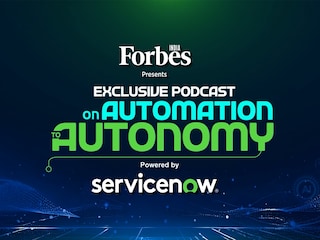ServiceNow’s Chris Bedi on why agentic AI will define the pace setters of the fu...
From automation to autonomy, businesses that adopt agentic models early will unlock speed, productivity, and a competitive edge


Artificial intelligence has moved beyond pilot projects and proof-of-concept exercises. It now influences how companies generate value, serve customers, and organize their workforce. The shift from generative tools that assist humans to agentic systems that operate independently is a fundamental change, not just an incremental one. In this context, Forbes India Anchor Mridu Bhandari interviewed Chris Bedi, Chief Customer Officer and Special Advisor to the Chairman on AI Transformation at ServiceNow, to explore what leadership entails as businesses transition from automation to increasing autonomy.
Q. Generative AI dominated conversations in 2024. But today the spotlight is on Agentic AI. In simple terms, what makes this shift from assistance to autonomy so critical for leaders right now?
“Agentic can truly provide exponential value to the enterprises,” Bedi said. “It can reason on its own. It can make decisions and execute things autonomously.” Generative AI has made individuals faster. Agentic AI transforms how a firm operates. It does not wait for prompts. It acts based on intent. That is why the gap between pace setters and followers keeps widening. “Those that are reinventing their workflows with agentic are generating 60 percent plus revenue improvement,” he noted. “We are seeing cycle times shrink by 90 percent.”
Q. Industry reports suggest pace setters are reaping 10x the financial impact. What separates leaders achieving exponential results from those stuck with incremental gains?
Urgency takes precedence. “You can’t wait. It’s here. It’s now,” Bedi said. “If the C-suite does not start adopting AI now, they may not have a company in five to six years.” Next comes clarity. Leaders select a small set of measures that span departments and then implement quick wins. “Start small. Get some small wins on board. Prove the value and then scale up to bigger use cases,” he said. Revenue per employee. Cycle time. Topline growth tied to specific journeys. These are scoreboards that keep momentum honest.
Q. But leaders are also grappling with anxiety among employees. How should they communicate the role of the workforce in this AI-first world?
People will continue to remain the biggest challenge. The solution isn't to defend outdated tasks, but to shift talent toward higher-value activities and communicate this plan clearly and early. "Over ninety percent of our technology support teams no longer need to handle those tasks," Bedi explained regarding ServiceNow’s own transition. “We relocated them to roles centered on growth, leading to happier employees and tangible benefits." As systems evolve, new roles will emerge. For example, yesterday, no one was hired for search engine optimization; however, in the future, companies will likely seek experts in agent orchestration, and policy design.
Q. Beyond people, there’s also a question of architecture. Why is a platform-based approach critical for scaling AI value instead of chasing point solutions?
The choice of platform is crucial. Point solutions add complexities and hinder adoption. “Not taking a platform approach actually increases your complexity and decreases your outcomes,” Bedi said. “A platform with AI, data, and workflows working seamlessly together reduces the time to innovate and accelerates results.” Consistent interfaces simplify governance and make it easier for teams and customers to trust what they are using.
Q. How do you see experiences, both consumer-facing and employer-facing, —shifting with Agentic AI in the next few years?
Experience will feel different on both sides of the glass. “AI is the new UI,” Bedi said. “Everything will be a conversational interface.” For customers, this means agents that guide every step, from onboarding to renewal, with memory and context. For employees, it means function-specific agents that handle repetitive volume, so humans can focus on the critical tasks. “We have agentic agents now processing two-thirds of the volume for accounts receivable,” he said. “That frees time to improve collectability and cash flow.”
Q. Speed and innovation often come with risk. What governance frameworks must leaders adopt to ensure trust and compliance while scaling?
Governance belongs inside the operating model. The strongest programs ask two questions before a build begins. Are we allowed to do this? Should we do this? They define how sensitive data is handled. They track the efficacy of automated decisions. “Organizations are going to have to answer the question: how many decisions did AI make today and how sure are you about them,” Bedi said.
Q. And what about India—how do you see legacy businesses balancing tradition with the push toward agility and AI-native structures?
India’s transformation is already evident. In financial services, loan processing has been accelerated from days to minutes. “We collaborated with a lender to reduce the time from interest approval to issuance from seven days to seven minutes,” he stated. Such small successes transform belief into tangible action.
Q. If you had to paint a picture of leadership in 2030, when autonomy is the norm, what must leaders do today to be ready?
Bedi’s forecast for 2030 emphasizes increased focus and workload. “Leaders will have more time to focus on innovation, strategy, and rethinking the customer experience,” he said. The message is clear: “Go all in. There’s no substitute for learning by doing.” Start now. Set targets to drive redesign. Train all team members. Choose a scalable platform. Communicate persistently until fear diminishes. Autonomy will become standard. The winners will be those who transform urgency into thoughtful design and measurable results.
First Published: Oct 31, 2025, 13:41
Subscribe Now